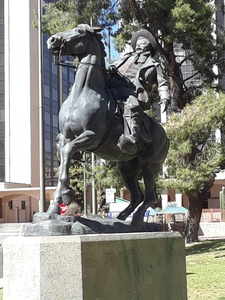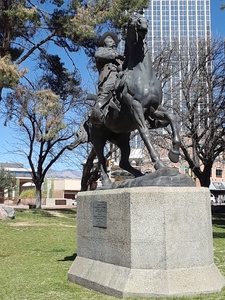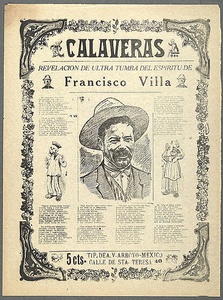On December 2, 1915, there was a terrible massacre committed by General Francisco Villa, in the town of San Pedro de la Cueva, in the state of Sonora, in the north of the country. This left a balance of 85 inhabitants shot, as well as people of Chinese origin and the village priest.
Due to the constant attacks by gavilleros and deserter soldiers that devastated the region, the town's inhabitants had decided to organize themselves into armed groups to explore the roads. In those days the rumor spread that parties of bandits were approaching, and on December 1st a group of residents led by the municipal president José María Cruz, Pedro Félix and Práxedes Noriega, opened fire from the Cajete hill against armed men, without know that it was a group of villistas.
After a few minutes of shooting, upon learning that they had come into contact with a large armed force, the defenders fled to the nearby hills, leaving their comrade Noriega and five of Villa's men dead.
The next day, the revolutionary was furious at what had happened, so he ordered Margarita Orozco to arrest all the inhabitants of the town, including women and children. After this, the Villistas searched house by house, and recruited almost 300 civilians in front of the parish church.
Macario Bracamontes, a Villista commander, originally from Sonora, begged Villa not to murder women or children, to which the revolutionary agreed, however, the remaining 136 men, including minors, were lined up next to the Catholic temple to be shot.
The Villistas started the detonations, firing four by four or six by six, while the minors who were not spared walked backwards crying and begging for their lives to be spared.
The priest, Flores, from that place, returned to Villa and on his knees asked him to forgive the prisoners, but he did not listen and threatened to kill him. The massacre continued and the priest again begged to leave the citizens alone, however, this time Villa took out his pistol and shot him twice in the left side and once in the head.
This event continued until Colonel Bracamontes drew his pistol and challenged Villa to draw his, while yelling that not one more man was going to die, then Villa turned to the line of condemned and spared the lives of some adolescents and adults. . But by that time, 85 men had already been executed, 80 inhabitants, six of them of Chinese origin, and five foreigners.
After the fact, several women were raped by the Villistas, and then Villa gave the order to set the town on fire and from the heights of the Batu church, verified that his orders had been carried out. At present, there is a monument and a plaque with the names of the sacrificed residents. [0]
 Statue of Pancho Villa at Veinte de Agosto Park, Tucson, Arizona.
Statue of Pancho Villa at Veinte de Agosto Park, Tucson, Arizona.
Location and description of the statue.
The statue of Pancho Villa is located at Veinte de Agosto Park in Tucson Arizona. The statue itself is made of bronze and towers at a height of fourteen feet and weights approximately five tons. The statue was created by “Julian Martinez and foundryman Javier Portilla” in the 1980s.[1]
History of the statue
How did Tucson acquire the statue?
The statue of Pancho Villa has had a very controversial past ever since it was first erected in Tucson in the 1980s, and the statue’s controversy persisted throughout the decades. The statue was erected in Tucson in June 1981 and was a gift from the Mexican press organization “Agrupacion Nacional Periodista” as well as from the Mexican government [2]. The statue was given to Arizona in friendship according to former Arizona Governor Bruce Babbitt, and it was accepted by the city of Tucson by former Tucson’s director of operations Tom Price. [3] After the statue was accepted by the director of operations it found its home in Tucson, but it was not welcomed by everyone.
 Statue of Pancho Villa at Veinte de Agosto Park, Tucson, Arizona.
Statue of Pancho Villa at Veinte de Agosto Park, Tucson, Arizona.
The Unveiling Ceremony.
Former Tucson mayor Lewis Murphy had boycotted the statue’s unveiling ceremony due to the controversial figure that the statue portrays.[4] Regardless of the mayor’s boycott of the statue the unveiling ceremony of the statue occurred. Crowds of people came to the statue’s unveiling ceremony, although the specific amount of people who attended fluctuates between accounts. Comparing between different accounts the number of people who attended the unveiling was between six hundred to one thousand people. Among the attendees at the ceremony were Pancho Villa’s descendants, both his son and granddaughter arrived in Tucson to see the statue be unveiled.[5] After the unveiling of the statue however there was a mixture of emotions about the statue. Some then as many do now, see the statue as a representation and celebration of Mexican American culture.[6] Others view the statue in a less positive way and argue that the statue should be removed. One of the main reasons for this argument relates to the person the statue represents, Pancho Villa and his past deeds.
 Calaveras, revelación de ultra tumba del espíritu de Francisco Villa.[7]
Calaveras, revelación de ultra tumba del espíritu de Francisco Villa.[7]
Brief history of Pancho Villa.
In order understand the controversies related to the statue it is best to know about the history of Pancho Villa himself. Born in Durango Mexico. In 1887, Francisco Pancho Villa is a noteworthy individual in both the history of Mexico and in the history of the southwestern United States.[8] This can be attributed to the infamous acts he committed, as well as for his accomplishments during the Mexican revolution. In the beginning of the twentieth century Villa” joined Francisco Madero’s uprising against Mexican President Porfirio Díaz in 1909.”[9] This deed cemented Villa’s status as a revolutionary for his contributions in fighting the dictatorship of Porfirio Díaz. However, Villa’s life was not all shining accomplishments, and he did commit several crimes as well as being a notable revolutionary. One of Pancho Villa’s most well-known deeds was when he crossed the border into the United States in 1916 and killed several American citizens in the city of Columbus New Mexico.[10] This event led to Pancho Villa becoming vilified in the United States and is the most sited reason for the removal of the statue. While Pancho Villa was assassinated in 1923 his legacy still lives on today.
Controversy.
Because the statue portrays such a controversial figure, it was expected that the same would be attributed to the statue itself. Ever since the statue was first erected there has be numerous attempts to remove it. There have been numerous other attempts to remove the statue and everyone of these attempts are representative of the growing acceptance of the statue by the community. In the 1982 edition of the Newsweek, reported that one Tucsonan was suing the major of Tucson, Lew Murphy, for causing their emotional distress that was brought on by the statue.[11] This report occurred only one year after the unveiling of the statue and shows the public backlash towards it at this time. According to a 2011 article by the Arizona Daily Star, a teacher from Pima Community College began to protest the statue in 1989 and cited their reason for protesting the statue was due to Villa’s actions in Columbus New Mexico.[12] Moreover, the teacher continued his protest the next year before, but was discouraged to continue due to the amount of counter protesters in favor of the statue.[13] The recording of counter protesters shows how the local community is becoming more accepting of the statue. In 2018 the conservative legal group Judicial Watch attempted to remove the statue by stating that the statue “constitutes a public safety issue because people have to cross the street to look closely at it” and that the public is generally opposed to the statue.[14] These claims were both dismissed by Democratic Ward 6 representative of Tucson City Council Steve Kozachik. Nonetheless the media at this time heavily reported on Judicial Watch’s attempt to remove the statue. During this time many people began to voice their opinion on the statue and its value to the community.
 The plaque at the base of the statue.
The plaque at the base of the statue.
Defense of the statue.
Unlike when the statue was first unveiled, in recent years there have been numerous accounts of people who are in support for the statue’s presence in Tucson. After there was a call to remove the statue in 2018 many people voiced their opinions of the statue, including several University of Arizona professors. Even Democratic Ward 6 representative Steve Kozachik stated that he “opposed the removal of the statue the first time, and have now done so again” In his January 2019 newsletter.[15] Others have stated that the statue is important to the community because it celebrates Mexican-American culture.[16] It is reasonable that the statue’s presence today is partly due to the support from the local community in recent years.
Related links
https://www.kold.com/2018/12/12/controversy-over-downtown-statue-pancho-villa/
https://www.allaboutarizonanews.com/removal-of-pancho-villa-statue-rejected-by-tucson-committee/
https://kvoa.com/news/2018/12/11/group-pushes-for-removal-of-pancho-villa-statue-at-veinte-de-agosto-park/
http://www.judicialwatch.org/wp-content/uploads/2018/12/Request-for-Deaccession-Villa-Letter.pdf
https://remezcla.com/culture/pancho-villa-phoenix-statue/
[1] “Pancho Villa Statue.” Pima County Public Library. Accessed March 16, 2021. https://www.library.pima.gov/content/pancho-villa-statue/.
[2] Montini, EJ. “Should Pancho Villa Statue in Tucson Be Removed, as Happened with Confederate Monuments?” The Arizona Republic. Arizona Republic, August 2, 2020. https://www.azcentral.com/story/opinion/op-ed/ej-montini/2020/08/02/should-pancho-villa-statue-tucson-removed/5552822002/.
[3] Admin. Pancho and Tom - how the Villa statue came to Tucson, February 6, 2014. http://a-mountain.com/?p=1347.
[4] Admin. Pancho and Tom - how the Villa statue came to Tucson, February 6, 2014. http://a-mountain.com/?p=1347.
[5] “PANCHO VILLA STATUE UNVEILED IN ARIZONA.” The New York Times. The New York Times, July 2, 1981. https://www.nytimes.com/1981/07/02/us/pancho-villa-statue-unveiled-in-arizona.html.
[6] Associated Press. “Tucson Won't Remove Pancho Villa STATUE, Despite CONSERVATIVE Group's Request,” December 17, 2018. https://www.nbcnews.com/news/latino/tucson-won-t-remove-pancho-villa-statue-despite-conservative-group-n949101.
[7] Posada, José Guadalupe, Calaveras, revelación de ultra tumba del espíritu de Francisco Villa, Photograph, 1923, (Mexico City: Antonio Vanegas Arroyo), https://www.loc.gov/item/99615835/
[8] Francisco Pancho Villa of Mexico. Accessed March 23, 2021. https://www.sjsu.edu/faculty/watkins/villa.htm.
[9] History.com Editors. “Pancho Villa.” History.com. A&E Television Networks, November 9, 2009. https://www.history.com/topics/mexico/pancho-villa.
[10] Otero, Lydia R. “The Francisco ‘Pancho’ Villa Statue: Tucson’s Welcoming Mat.” Scribd. Scribd. Accessed March 18, 2021. https://www.scribd.com/document/395500286/History-of-Pancho-Villa-Statue.
[11] "Pancho Villa Rides Again—in Tucson." Newsweek, Aug 02, 1982, 42, http://ezproxy.library.arizona.edu/login?url=https://www-proquest-com.ezproxy1.library.arizona.edu/magazines/pancho-villa-rides-again-tucson/docview/1866719628/se-2?accountid=8360.
[12] Villarreal, P. (2014, September 05). Tucson oddity: Villa statue still riding high. Retrieved March 20, 2021, from https://tucson.com/news/local/tucson-oddity-villa-statue-still-riding-high/article_fa51e33a-a18c-5e4e-a182-e4beccdac967.html
[13] Villarreal, P. (2014, September 05). Tucson oddity: Villa statue still riding high. Retrieved March 20, 2021, from https://tucson.com/news/local/tucson-oddity-villa-statue-still-riding-high/article_fa51e33a-a18c-5e4e-a182-e4beccdac967.html
[14] “Steve K's Newsletter 12/10/18.” Official website of the City of Tucson, December 10, 2018. https://www.tucsonaz.gov/ward-6/news/steve-ks-newsletter-121018#Pancho.
[15] “Steve K's Newsletter 01/22/19.” Official website of the City of Tucson, January 23, 2019. https://www.tucsonaz.gov/ward-6/news/steve-ks-newsletter-012219#Pancho.
[16] Associated Press. “Tucson Won't Remove Pancho Villa STATUE, Despite CONSERVATIVE Group's Request,” December 17, 2018. https://www.nbcnews.com/news/latino/tucson-won-t-remove-pancho-villa-statue-despite-conservative-group-n949101.


